The newly enhanced San Francisco Museum of Modern Art (SFMOMA) officially re-opens to the public on May 14, 2016, but a flurry of press previews, member events, a pink-lit splashy gala that artists like Chuck Close attended dressed in their best out-of-the-box attire, a fancy ball, and even an ABC News Special have already inaugurated the museum. And it is worth all the fanfare and more.
Wedged in at a right-angle between 3rd Street and Howard Street, the Snøhetta addition includes 170,000 square feet of extra indoor and outdoor gallery space, the largest living green wall in the Bay Area, three restaurants, two museum shops, a state-of-the-art conservation studio, a theater, gender-neutral bathrooms and a lower level filled with art that is free and open to the public.
.
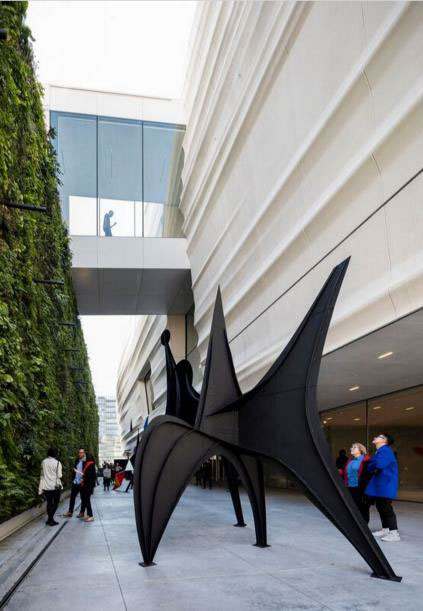
Pat and Bill Wilson Sculpture Terrace featuring Alexander Calder’s "sculpture Maquette for Trois Disques (Three Disks), formerly Man" (1967) and the living wall, designed by Habitat Horticulture. Photo: © Henrik Kam, courtesy SFMOMA.
.
Costing $305 million, the renovation was enabled by a deal struck between the Fisher family (founders of the Gap) and SFMOMA to house the Fishers’ 1,100-work collection for the next 100 years. Originally, Doris and Donald Fisher had wanted to build their own museum in the Presidio district of San Francisco, but after two years of strong community opposition to their plan, the Fishers agreed to place their “trust” with SFMOMA.
But before discussing the Fisher Collection and what it means to San Francisco and to the way museums are doing business now, a look at the building is in order.
The first thing one notices about the Snøhetta addition is that it is set back from the crowded footprint of the surrounding cityscape and consequently bathed in light. The façade is constructed of a rippling white, 10-story high slab made in polystyrene molds and consisting of a composite that includes fiberglass and sand from the beaches of Monterey. Sand that glints in the light.
.
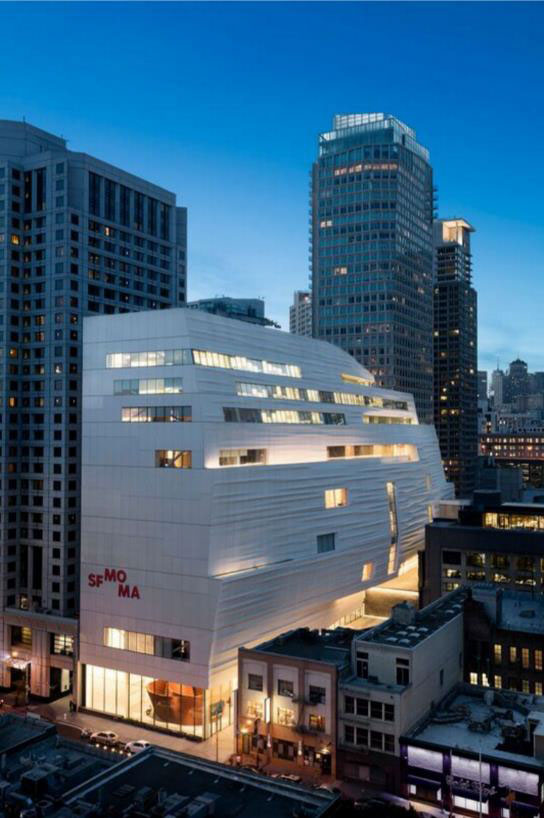
Snøhetta expansion of the new SFMOMA, 2016. Photo: © Henrik Kam, courtesy SFMOMA.
.
This white, undulating exterior acts as a backdrop to the old SFMOMA, a Mario Botta postmodern masterpiece. Butto’s 1995 muscular brick gem is now allowed to pop against the more subdued curtain of the Snøhetta building, which also draws in the surrounding architectural landscape.
.
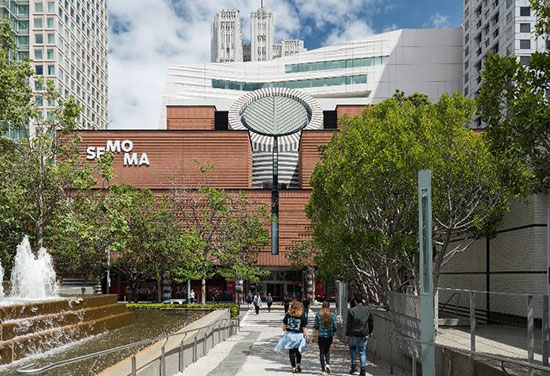
The new SFMOMA, view from Yerba Buena Gardens. Photo: Jon McNeal, © Snøhetta.
.
The Snøhetta, though structurally the opposite of the Butto, is, in fact, a seamless integration of space and design. The white color of the Snøhetta was chosen partially to match the white stonework of the Butto oculus. Endeavoring to create a new model for the art experience, the building adapts the culture of the Bay Area tech and start-up aesthetic. Instead of stamping a huge, ostentatious statement on the neighborhood, the architects sought to interact with their environs, and they have succeeded admirably. In other words, it is an inclusive design.
.
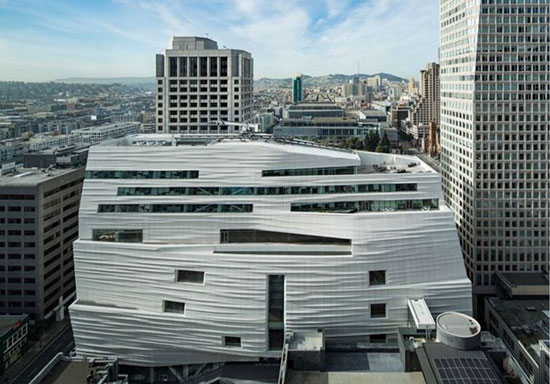
Snøhetta expansion of the new SFMOMA, 2016. Photo: © Henrik Kam, courtesy SFMOMA.
.
Once inside it is nearly impossible to distinguish what is old space from what is new space; the building keeps unfolding. Room after room opens up, like a palace, or a great swath of fabric that just continues to unfurl as you walk through it. The staircases are airy, the wood light, the lighting design in the ceiling mimics natural light. And best of all, the only way I could tell where I was, whether wandering through the old Butto or the new Snøhetta, was by the art on the walls. Because one of the key points in the deal between the Fishers and SFMOMA was that, in exchange for the gift of undisclosed funds for the new building, the Fishers requested that SFMOMA not only show a monolithic exhibit devoted to the Fisher Collection every 10 years, but that all the new galleries must, at all times, display 75 percent Fisher art.
.
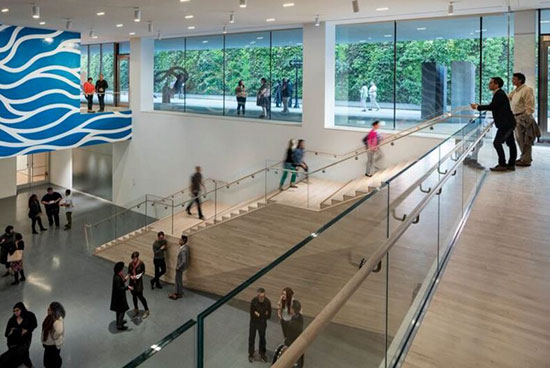
Helen and Charles Schwab Hall featuring Sol Lewitt’s "Wall Drawing 895: Loopy Doopy (white and blue)," (1999) at SFMOMA. Photo: © Henrik Kam, courtesy SFMOMA.
.
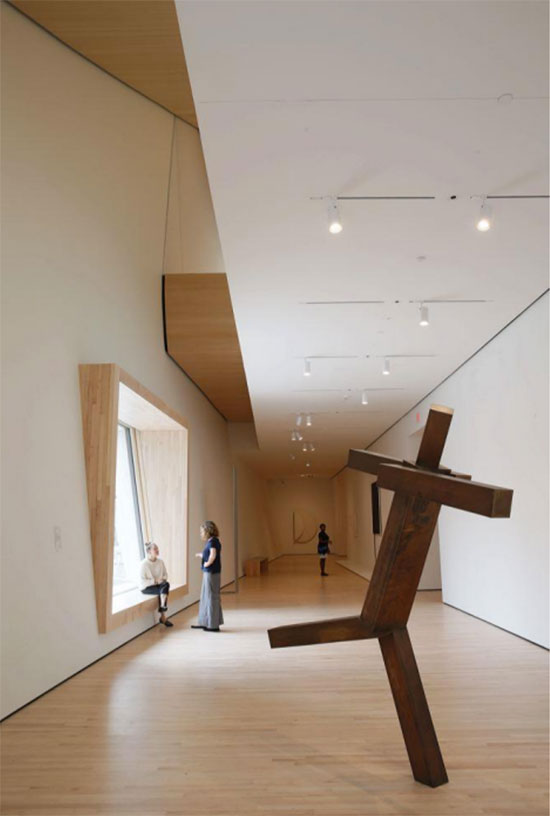
A City Gallery at SFMOMA featuring "Untitled" by Joel Shapiro (1989). Photo: © Iwan Baan, courtesy SFMOMA.
.
The Fishers collected deep, but not wide. When they found an artist they liked, they bought much of that artist’s entire oeuvre. They favored Pop, Minimalist, and Abstract Art, though they also liked the post-war German work of Gerhard Richter, Sigmar Polke and Anselm Kiefer. On view in the Fisher galleries at SFMOMA is an octagonal chapel-like room devoted to Agnes Martin, one of Doris Fisher’s favorite artists.
Also on display are two rooms of Andy Warhol, two rooms of Chuck Close, and two rooms devoted to Ellsworth Kelly. As Donald Fisher once said, “We didn’t buy artists we didn’t like.” Who can blame him? A museum, though, must have different standards. A museum must collect wide as well as deep.
.
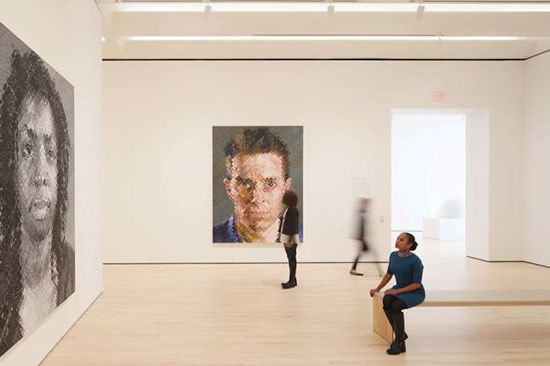
"Pop, Minimal, and Figurative Art: The Fisher Collection" exhibition featuring works by Chuck Close. Photo: © Iwan Baan, courtesy SFMOMA.
.

"Approaching American Abstraction: The Fisher Collection" exhibition featuring works by Ellsworth Kelly. Photo: © Henrik Kam, courtesy SFMOMA.
.
Don’t get me wrong: it’s all excellent art, all expensive art, but not much of it is surprising art. Like the Gap, the Fisher Collection is a brand, and it’s a brand that is primarily dominated by post-war, blue-chip, contemporary male artists with a few female exceptions that include Joan Mitchell and Agnes Martin.
And yet, this Fisher display is only SFMOMA’s opening foray. A sortie that needs to celebrate both the new building and the new collection. By all accounts, SFMOMA hopes to capitalize on the strength of this outsized and outstanding gift in order to explore curatorial pairings that would otherwise not be possible. The museum is already the permanent home of a spectacular Jackson Pollock painting—Guardians of The Secret, Henri Matisse’s Femme au chapeau that christened the Fauvist movement in art when it was first exhibited in 1905, and a sizeable gift of Clyfford Still’s powerful abstractions.
In addition, the museum boasts the largest space dedicated to photography in the United States, as it was one of the first museums to recognize photography as an art form.
Perhaps this is where the newly enhanced SFMOMA shines: in its ability to recognize not just artistic innovation, but experiential innovation. SFMOMA wants to play on all platforms. On May 14, when the museum officially opens to the public, it will launch a new app created jointly with the SF startup company, Detour. Combining storytelling with cutting-edge positioning technology, the app will keep tabs on where visitors are in the museum (and the surrounding landscape) and will also take them through the space with actors, comedians, sports and cultural figures guiding and enhancing their museum experience.
More than just architectural, SFMOMA wants to offer a paradigm shift. For me, the “aha” moment—the moment I knew I was being engaged in a new model for the art world experience—came when I first set foot in the museum. Instead of encountering a person behind a desk, I was greeted by a t-shirt clad smiling young person with a tablet. “How can I help you?” this person asked. “Where do you want to go? What do you want to see?” My God, after years, a lifetime of stone-faces barricaded behind high desks ignoring my desire to see art, here was an authentic interaction.
Yes, it felt a little like entering the Apple Store, but that’s not so bad. I felt welcome. I felt at home.
____________________________
BASIC FACTS: The new San Francisco Museum of Modern Art (SFMOMA) and its new Snøhetta addition will open on May 14, 2016. The museum is located at 151 Third Street, San Francisco, CA 94103. www.sfmoma.org
_____________________________
Copyright 2016 Hamptons Art Hub LLC. All rights reserved.
